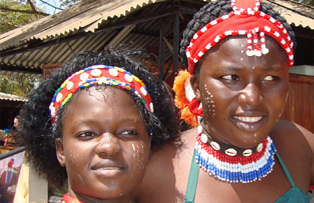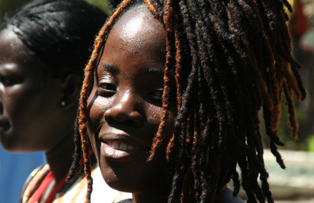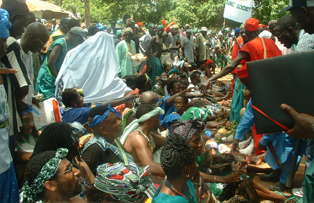

Mandinka originates from the (Manding) Mali Empire. Sundiata Keita, leader of the Malinké people encompassed the areas from the edge of the Sahara to the forests of the south in what is now Liberia & Sierra Leone. From east to west, it covered all the regions between Takedda beyond the Niger Buckle covering Senegambia on the Atlantic Ocean. This vast empire controlled nearly all the trans-Saharan trade, and contact with the rulers of the Arab states to the north led the Mali rulers to embrace Islam with great enthusiasm. Though the rise of the Mali Empire was swift, its decline was slow. By the middle of the 15th century a group of Mandingos drifted into the area of the Gambia River basin and with them came Islam. The Mandinka make up the majority of the population being the largest tribe to settle in The Gambia, the majority of which live in the provinces, Upper and Central River Divisions.

WOLOF are an ethnic group found in north Senegal, Mauritania and The Gambia, making up about 15% of the population, yet Wolof language and culture have a disproportionate influence because of their prevalence in the capital Banjul, where 50% of the population are Wolof. Wolof ceremonial traditions, such as weddings, while not unique, have distinctive traditional elements. Many aspects of these traditional ceremonies have merged and been modified through the 20th century. Traditionally, the parents of the groom-to-be send elders to the girl‘s parents with kola nuts and money to ask for her hand in marriage. The girl‘s parents consult their daughter and either consent to or reject the proposal. If accepted, the parents of the bride-to-be distribute the kola nuts amongst the family and neighbors – an informal way of announcing the impending wedding. In more traditional practices, the groom to be‘s family paid the girl‘s bride-price in the form of money. This tradition, where surviving has been modernized and dowry is paid in money, cars or even houses. The imam and elders advise the groom with the presence of the some representatives of the bride‘s parents. Weddings traditionally take place at the groom’s home. Parents receive guests with food and drink (but not alcohol), while guests bring gifts of money, rice and drinks. After the ceremony people feast and dance with guests hiring a griot (praise-singer) and giving further gifts to the groom‘s parents. The girl moves to the husband’s (or his parent’s) home or compound, bringing utensils for cooking which she buys with the money from the bride price.

JOLA are the next largest community living in the Gambia, their people are believed to have pre-dated the Mande and Fula peoples to the riverside coast of Senegambia, and may have migrated into Casamance before the 13th century. Though the origin of the Jolas is still unknown, it is now confirmed by both oral and written history that they are the people who have been longest resident in The Gambia and among the indigenous people of the Senegambian region. Jola in Mandinka means to “pay your dues”. Tradition-ally Jola women tend the fields and grow crops while the men tap palm oil and wine.
SARAHULI are Mandé people who descend from the Belfour and are closely related to the Imraguen of Mauritania. They were the founders of the ancient empire of Ghana c. 750-1240 CE). The settlers in The Gambia are a minority group who live mainly in the Upper River Division. Traditionally they are traders, and are renowned as being successful business people, many are property owners and diamond dealers.
SERERE are the third largest ethnic group in Senegal, also present in Mauritania and the north bank of The Gambia. They are predominantly fishermen by trade and their principal sport is wrestling.
FULA are traditionally a nomadic, pastoralist, trading people, herding cattle, goats and sheep across the vast dry hinterlands of their domain, keeping somewhat separate from the local agricultural populations. Their tribe can be found as far north as Mauritania, all over West and central Africa and as far east as Sudan. The Fula people form a minority in every country they live, except Guinea where they represent a plurality of the population (40%). In The Gambia they are often found as local trades. Commonly the corner shop will be known as the “Fula shop”.
AKU originated from Freetown, Sierra Leone, some still live in the area of George town where they had been resettled after the days of slavery as there was no way of know-ing where they had originally been taken from. The Aku language which is still spoken in West Africa developed from the early West African Pidgin English. Some scholars also argue that African slaves took this language to the New World where it helped
MANJAGO are an ethnic group in Guinea-Bissau. Which have migrated to south Gambia They are known as Manjaku by the Manjacks themselves, Ndiago by the Wolofs, Manjaco by the Portuguese, and Manjaque by the French. Each of these terms means “I tell you” Their trade by tradition is typically palm wine and palm oil tapping.